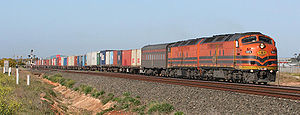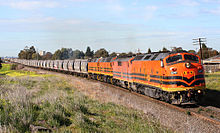- Commonwealth Railways CL class
-
This article is about the diesel locomotives. For the car produced by the German automaker, see Mercedes-Benz CL-Class.
CL / CLF / CLP class 
CLF class locomotives operated by Australian Railroad Group. Power type Diesel-electric Builder Clyde Engineering, Grantville Model AT26C (CL), AT26C-2M (CLF), AT26HC-2M (CLP) Build date 1970 Total produced 17 Configuration Co-Co Gauge Standard Gauge Length 19.58m Prime mover EMD 16-645E3 (CL), EMD 16-645E3C (CLP/CLF) Power output 2460 kW/3300 HP The CL class are an Australian diesel electric locomotives ordered by the Commonwealth Railways and delivered between 1970 and 1972. Altogether, 17 units were built by Clyde Engineering, Granville to a local design using imported EMD engines and traction equipment. The class was the last in the world to be built with the EMD bulldog nose,[1][2] but differed from those before in having a mansard roof above the carbody. They were delivered in the standard Commonwealth Railways livery of maroon and silver.
Contents
Construction
In late 1968 the Commonwealth Railways placed an order for five new 2237 kW locomotives with Clyde Engineering to cater for increased traffic on the Trans-Australian Railway, then being connected through to Perth and Sydney via new standard gauge links.[3] They were electrically and mechanically similar to the WAGR L class of 1967, but the initial design was to have a Do-Do wheel arrangement and a USA style EMD FP45 cab. This was later changed to a streamlined carbody. The first locomotive was completed in January 1970 at Clyde's Sydney works, with additional locomotives being order after their early success.[3] The AL class of 1976 used the same mechanical package but in a double cabbed box carbody.
Rebuilding
The locomotives were passed to Australian National after its establishment, and from 1992 the whole fleet were rebuilt into either the CLF and CLP classes by Morrison Knudsen Australia (MKA). By this time the locomotives had a relatively modern design with a strong frame, but were limited by their old technology control equipment.[4] For the purposes of the contract the locomotives were sold to MKA and then leased back for 12 years. Clyde Engineering and Goninan were other contenders for the contract, which also included the rebuilding of eight slightly newer AL class locomotives. The seven CLFs were intended for freight, while the 10 CLP class were fitted with a head end power generator for use with passenger trains such as the Indian Pacific, The Ghan, and The Overland.[4]
The rebuilding involved stripping back to the frame, with everything except for the nose section and monocoque frame removed. Changes included the EMD 645E3 engines being replaced with overhauled EMD 645E3C engines imported from MKA's parent company in the USA, the original main alternators were rebuilt from AR10/A4-D14 to the AR10/A9-D14 type, refurbished D78 traction motors replaced the originals along with a new gear ratio, and new MK-LOC microprocessor controls were fitted. The cab was upgraded to modern standards, the brake setup was also changed from twin to single shoe per wheel, and a number of other small fixes were made to assist maintenance.[4]
After rebuilding the locomotives did not retain their numbers, for example the first locomotive converted was CL2 which emerged as CLF1. All were back in service by the end of 1993. The CLF appeared in the standard AN green with yellow data panel, strip and B-end. The CLP received a unique livery, with a lighter green nose, silver carbody, and a yellow stripe running from the nose to the rear.[4]
Australian National lost their interstate freight role with the creation of the National Rail Corporation in 1994. The contract with MKA meant the locomotives could only be used on AN trains, or a higher lease fee would apply. As a result the class were not seen on NR operated trains, and did not venture onto the wider national standard gauge network until AN won "hook and pull" contracts for private operator SCT.[4]
While built for passenger traffic, it was not until 1994 that a CLP class was used on the entire Indian Pacific route from Sydney to Perth - before this time New South Wales and Western Australia used their own locomotives on the train when within their state borders. On conversion to standard gauge in 1995 The Overland was also hauled by the CLP class.[4] The use of the CLP class on passenger trains came to an end in November 1997, when the passenger operations of Australian National were sold to Great Southern Railway, who contracted National Rail for the supply of locomotives to haul their trains.
CLP15 (formerly CL1) was involved in the Mount Christie head on collision in February 1997, being stored for several months before scrapping in November the same year.[4]
Private ownership
In November 1997 ownership of the class was transferred from AN and MKA to Australian Southern Railroad (later part of the Australian Railroad Group (ARG)) along with Australian National's mainline freight operations. The class soon lost the AN logos on the nose and carbody, with repainting in their orange and black commencing in 1998.[4] With the split of the ARG joint venture in 2006 the class are now divided between Australian Railroad Group (now QR National) and Genesee and Wyoming Australia (GWA), both using the class on interstate freight trains.
Locomotives
Locomotive Named (prior to rebuild) Entered service Rebuilt into Named (after rebuild) Current Owner Status CL1 John Gorton February 1970 CLP15 Kokatha Australian National Scrapped CL2 March 1970 CLF1 City of Whyalla Australian Railroad Group, a QR Company In Service CL3 April 1970 CLP13 Nukunu Australian Railroad Group, a QR Company In Service CL4 May 1970 CLP14 Barngarla Genesee & Wyoming Australia In Service CL5 July 1970 CLF4 Australian Railroad Group, a QR Company In Service CL6 November 1970 CLF6 Genesee & Wyoming Australia In Service CL7 November 1970 CLF3 Australian Railroad Group, a QR Company In Service CL8 January 1971 CLP17 Arabana Genesee & Wyoming Australia In Service CL9 Gough Whitlam March 1971 CLP8 City of Port Augusta Genesee & Wyoming Australia In Service CL10 April 1971 CLP 16 Murunitja Genesee & Wyoming Australia In Service CL11 June 1971 CLF2 Australian Railroad Group, a QR Company In Service CL12 July 1971 CLF5 Genesee & Wyoming Australia In Service CL13 Ausgust 1971 CLP9 Wiljakali Australian Railroad Group, a QR Company In Service CL14 Charlie Jones December 1971 CLP11 Kaurna Australian Railroad Group, a QR Company In Service CL15 January 1972 CLP 12 Ngadjuri Australian Railroad Group, a QR Company In Service CL16 March 1972 CLF7 Australian Railroad Group, a QR Company In Service CL17 William McMahon June 1972 CLP 10 Mirning Australian Railroad Group, a QR Company In Service References
- ^ Oberg, Leon (2007). Locomotives of Australia 1854-2007. Rosenberg Publishing. p. 360. ISBN 1877058548.
- ^ "AN: CL Class:". 5 September 2007. http://locopage.railpage.org.au/anr/cl.html. Retrieved 7 June 2008.
- ^ a b Leon Oberg (1962). Locomotives of Australia. Rosenberg Publishing. p. 359. ISBN 9781877058547.
- ^ a b c d e f g h Antony Fitzgerald (1962). Morrison Knudsen in Australia. Eveleigh Press. pp. 6–43.
External links
Commonwealth Railways / Australian National locomotives Diesel-Electric (standard gauge) Diesel-Electric (narrow gauge) Diesel-Hydraulic (narrow gauge) Categories:- Diesel locomotives of Australia
- Clyde Engineering locomotives
- Co-Co locomotives
- Railway locomotives introduced in 1970
Wikimedia Foundation. 2010.

